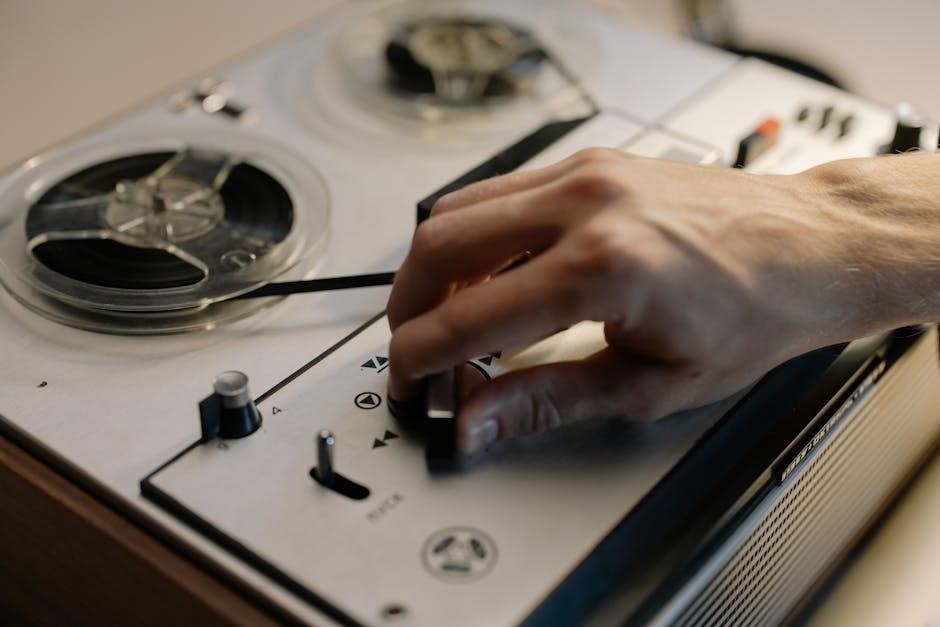Welcome to the official guide for Honeywell humidifier operation․ This manual provides essential instructions to help you understand and optimize your humidifier’s performance for better health, comfort, and home protection․
Overview of Honeywell Humidifiers
Honeywell humidifiers are designed to enhance indoor air quality by adding moisture to dry spaces․ Available in various models, including cool mist and warm mist options like the HUL570 and HEV355 series, these units offer adjustable humidity control and easy maintenance․ Many models feature demineralization cartridges to reduce mineral buildup and optional humidity monitors for precise control․ With a focus on reliability and user-friendly designs, Honeywell humidifiers cater to both small spaces and whole-house systems, ensuring improved comfort and health benefits for users․
Importance of Proper Humidifier Operation
Proper operation of your Honeywell humidifier is crucial for maintaining optimal indoor humidity levels, ensuring health benefits, and preventing damage to your home․ Correct usage helps avoid issues like mold growth, bacteria buildup, and over-humidification, which can harm both your family and belongings․ By following the guidelines, you can ensure efficient moisture distribution, reduce energy consumption, and extend the lifespan of your device․ Proper operation also enhances air quality, making your space more comfortable and healthier to live in throughout the year․
Safety Precautions and Guidelines
Always follow safety guidelines to avoid electric shock or damage․ Never operate the humidifier with wet hands or near water sources․ Keep it away from children and flammable materials․
General Safety Tips for Humidifier Use
- Always place the humidifier on a stable, flat surface to prevent tipping․
- Avoid placing the unit near open flames, hot surfaces, or flammable materials․
- Keep the humidifier out of reach of children and pets to avoid accidental damage or injury․
- Never operate the humidifier with wet hands or in areas prone to water spills․
- Regularly clean and maintain the humidifier to prevent mold and bacteria growth․
- Use distilled or demineralized water to minimize mineral buildup and prolong the unit’s lifespan․
- Follow the manufacturer’s guidelines for filling and operating the humidifier to ensure safe performance․
Electrical Safety Considerations
- Always plug the humidifier into a polarized 120V outlet to avoid electric shock․
- Never operate the unit with wet hands or while standing on a wet surface․
- Avoid modifying the humidifier or using damaged cords, as this can create electrical hazards․
- Ensure the unit is turned off and unplugged before cleaning or maintaining it․
- Keep the humidifier away from water sources and avoid submerging it in water․
- Use only the voltage specified in the manual to prevent electrical malfunctions․
Key Components of Honeywell Humidifiers
Key components include the filter, water tank, and mist output nozzle․ Accessories like humidity monitors and demineralization cartridges enhance performance․ Proper maintenance ensures longevity and efficiency․
Parts and Accessories Overview
Honeywell humidifiers feature essential parts like the wicking filter, water tank, and mist output nozzle․ Accessories such as demineralization cartridges reduce mineral buildup, while optional humidity monitors (e․g․, HHM10 or H10C) help maintain ideal moisture levels․ These components work together to ensure efficient operation and improved air quality․ Regular maintenance of these parts is crucial for optimal performance and longevity of the humidifier․
Understanding Humidity Control Mechanisms
Honeywell humidifiers utilize advanced mechanisms to maintain optimal moisture levels․ A built-in humidistat or optional external sensors monitor indoor humidity, adjusting output automatically․ Adjustable controls allow users to set desired levels, while evaporative technology ensures natural moisture release․ Optional demineralization cartridges reduce mineral buildup, enhancing performance․ These mechanisms work together to provide consistent comfort and prevent over-humidification, ensuring a healthy indoor environment year-round․

Installation and Setup Instructions
Choose a location with ambient temperatures between 32°F and 160°F, avoiding freezing areas․ Ensure supply plenum static pressure ≤0․4 in․ wc and water pressure ≤124 psi․ Install on the warm air stream plenum for optimal performance․
Choosing the Right Location for Your Humidifier

Ensure your Honeywell humidifier is placed in a location with an ambient temperature between 32°F (0°C) and 160°F (71°C)․ Avoid areas prone to freezing or extreme heat․ Install the humidifier on the supply (warm air stream) plenum, ensuring the supply plenum static pressure does not exceed 0․4 in․ wc and water pressure is ≤124 psi․ Keep it away from direct sunlight, moisture-sensitive surfaces, and furniture․ Place the unit on a level surface for proper operation and even moisture distribution․
Step-by-Step Installation Guide
Unpack the humidifier and read the manual․ Place the unit on a level surface in the desired location․ Ensure it’s installed on the supply plenum (warm air stream) and the static pressure does not exceed 0․4 in․ wc․ Connect the water supply line securely, ensuring proper drainage․ Plug the humidifier into a polarized 120V outlet․ Avoid operating with wet hands to prevent electric shock․ After installation, test the unit to confirm proper operation․

Operating Your Honeywell Humidifier
Turn the power knob clockwise to start the humidifier, adjust settings for desired output, and monitor humidity levels using a Honeywell monitor for optimal performance․
Powering On and Adjusting Settings
Plug the humidifier into a polarized 120V outlet, ensuring dry hands to avoid electric shock․ Turn the power knob clockwise to activate and adjust the settings for desired humidity․ Direct the mist output away from walls and furniture․ Use a Honeywell humidity monitor to track indoor levels and maintain the ideal range of 40-60%․ Adjust settings as needed to achieve optimal comfort and humidity control․ Regular monitoring ensures efficient operation and prevents over-humidification․
Monitoring and Maintaining Optimal Humidity Levels
Regularly monitor humidity levels to ensure they stay between 40-60%․ Use a Honeywell humidity monitor for accurate readings․ Check the water level daily and refill as needed to maintain consistent moisture output․ Adjust settings to prevent over-humidification, which can lead to mold growth and condensation issues․ Ensure the humidifier functions correctly and adjust as necessary for optimal performance․ Proper monitoring ensures efficient operation, protects your home, and enhances comfort, while maintaining a healthy indoor environment․

Maintenance and Cleaning
Regular cleaning is essential for optimal performance and hygiene; Replace filters as recommended and ensure proper drainage to prevent mold growth․ Refer to the manual for detailed procedures․
Regular Cleaning Procedures
Regular cleaning is crucial for maintaining your Honeywell humidifier’s efficiency and hygiene․ Clean the unit weekly by wiping down surfaces with a soft cloth and mild detergent․ Rinse thoroughly and dry to prevent mold growth․ Every 1-3 months, soak removable parts in a mixture of water and white vinegar to remove mineral deposits․ Always check and replace filters as recommended to ensure optimal performance․ Refer to the manual for specific cleaning instructions tailored to your model․
Filter Replacement and Care
Regular filter replacement is essential for maintaining your Honeywell humidifier’s performance and air quality․ Replace the filter every 1-3 months, depending on usage and water hardness․ Turn off and unplug the unit before replacing the filter․ Open the tank, remove the old filter, and install a new one from Honeywell․ Ensure it’s properly aligned and secure․ For reusable filters, rinse with water and vinegar to remove mineral buildup․ Avoid using harsh chemicals․ Replace filters as recommended to prevent mold growth and maintain efficiency․ Always use genuine Honeywell filters for optimal results․

Drainage and Water Management
Proper drainage and water management are crucial for maintaining your Honeywell humidifier’s efficiency and hygiene․ Regularly check the water level in the tank and drain excess water to prevent overflow․ Place the humidifier on a waterproof surface to avoid damage from accidental spills․ For models with a drainage tube, ensure it’s securely connected and directed away from the unit․ Clean the tank with water and vinegar weekly to remove mineral deposits and bacteria․ Always use fresh, clean water to fill the tank to maintain optimal performance and prevent mold growth․
Troubleshooting Common Issues
Address common issues like mist not being produced or noise by checking water levels, filter cleanliness, and ensuring proper installation․ Refer to the manual for solutions․
Identifying and Resolving Operational Problems
Common issues with Honeywell humidifiers include the unit not producing mist, excessive noise, or water leakage․ To resolve these, check the water level, filter cleanliness, and ensure the humidifier is properly plugged in․ If mist output is low, clean or replace the filter and verify that water is flowing correctly․ For noise issues, ensure the unit is placed on a stable surface and free from obstructions․ Regularly cleaning the humidifier and checking for blockages can prevent most operational problems․ Always refer to the user manual for detailed troubleshooting steps․
Humidifier Not Producing Mist or Noise Issues
If your Honeywell humidifier isn’t producing mist, ensure the water tank is filled and the filter is clean․ A clogged or dirty filter can restrict airflow, reducing mist output․ Check for any blockages in the mist outlet and ensure the humidifier is placed on a level surface․ For noise issues, verify that the unit is installed correctly and free from obstructions․ If the problem persists, refer to the troubleshooting section in the user manual or contact Honeywell support for assistance․
Additional Features and Accessories
Honeywell humidifiers offer optional accessories like demineralization cartridges to reduce mineral buildup and humidity monitors for precise control․ Filters and cleaning kits ensure optimal performance and hygiene․

Using Demineralization Cartridges
Demineralization cartridges are designed to reduce mineral buildup in your Honeywell humidifier, ensuring cleaner moisture output․ These cartridges trap minerals found in water, preventing white dust and scaling․ Simply install the cartridge as directed in your user manual․ Regular replacement, typically every 1-3 months, is recommended to maintain optimal performance․ Using a demineralization cartridge enhances humidity quality and prolongs the lifespan of your humidifier, ensuring efficient and healthy air humidification in your home․
Optional Humidity Monitors and Sensors
Honeywell offers optional humidity monitors and sensors to enhance your humidifier’s performance․ Models like the HHM10 or H10C allow you to track indoor humidity levels accurately․ These devices help maintain the ideal range of 40-60% humidity, preventing over-humidification․ By integrating with your Honeywell humidifier, they ensure consistent air quality and comfort․ While not included with all models, these accessories are highly recommended for precise control and optimal results, adding value to your home’s air quality management system․
Seasonal Shutdown and Storage
Properly shutting down and storing your Honeywell humidifier ensures longevity․ Clean and dry thoroughly, disconnect water supply, drain, and store in a dry place to prevent damage․
Preparing Your Humidifier for Off-Season
Before storing your Honeywell humidifier, ensure it is clean and dry to prevent mold growth․ Drain all water from the tank and reservoir․ Clean the unit thoroughly with a mild detergent and rinse well․ Allow all parts to air dry completely․ Disconnect the water supply and store the humidifier in a cool, dry place․ Check for mineral buildup and descale if necessary․ Follow manufacturer guidelines for seasonal shutdown to maintain performance and longevity․
Proper Storage Techniques
Store your Honeywell humidifier in a dry, well-ventilated area away from direct sunlight and moisture․ Place the unit upright to prevent water from seeping into internal components․ Cover the humidifier with a protective cloth to shield it from dust․ Avoid storing in basements or attics prone to humidity․ Keep all accessories, including filters and cartridges, in a separate, sealed container․ Ensure the storage location is out of reach of children and pets․ This will help maintain your humidifier’s condition until the next use․
Proper operation and maintenance of your Honeywell humidifier ensure optimal performance, health benefits, and home protection․ Refer to this guide for any questions and enjoy enhanced comfort year-round․
Final Tips for Optimal Humidifier Performance
- Always follow the manufacturer’s instructions for maintenance and cleaning to prevent mineral buildup and bacterial growth․
- Use genuine Honeywell demineralization cartridges to reduce mineral deposits in the water and improve humidifier efficiency․
- Monitor humidity levels regularly and adjust settings to maintain the ideal range of 40-60% for maximum comfort and health benefits․
- Store the humidifier properly during off-season to avoid mold growth and ensure it’s ready for next use․
- Refer to the user manual for troubleshooting common issues and ensure all repairs are done by authorized personnel․